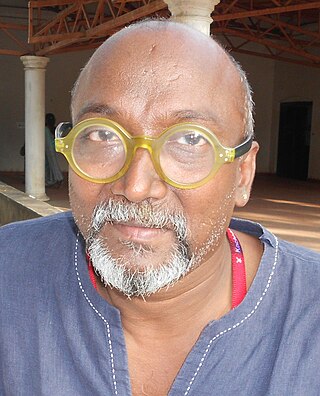
The Venice Biennale is an international cultural exhibition hosted annually in Venice, Italy by the Biennale Foundation. The biennale has been organised every year since 1895, which makes it the oldest of its kind. The main exhibition held in Castello, in the halls of the Arsenale and Biennale Gardens, alternates between art and architecture. The other events hosted by the Foundation—spanning theatre, music, and dance—are held annually in various parts of Venice, whereas the Venice Film Festival takes place at the Lido.

Harald Szeemann was a Swiss curator, artist, and art historian. Having curated more than 200 exhibitions, many of which have been characterized as groundbreaking, Szeemann is said to have helped redefine the role of an art curator. It is believed that Szeemann elevated curating to a legitimate art-form itself.

Hou Hanru is an international art curator and critic based in San Francisco, Paris and Rome. He is Artistic Director of the MAXXI in Rome, Italy.

Carolyn Christov-Bakargiev is an Italian-American writer, art historian and exhibition maker who has been serving as the Director of Castello di Rivoli Museo d'Arte Contemporanea and Fondazione Francesco Federico Cerruti in Turin since 2016. She was Edith Kreeger Wolf Distinguished Visiting Professor in Art Theory and Practice at Northwestern University (2013-2019). She is the recipient of the 2019 Audrey Irmas Award for Curatorial Excellence.

Bose Krishnamachari is an Indian painter and artist-curator based in Mumbai, India. He was born in 1963 at Mangattukara village near Angamaly, Kerala. He had done his early schooling at Government Higher Secondary School, Puliyanam. He took his BFA from Sir J. J. School of Art, Mumbai in 1991, and then completed his MFA from Goldsmiths' College, University of London in 2000.
The Wassmann Foundation, Washington, D.C, is an arts collective based in Melbourne, Australia. Founded in 2001, the collective has a rotating membership from a range of fields, including artists, writers, curators, musicians and film-makers. The foundation oversees the estate of the fictitious Leipzig modernist and sewerage engineer Johann Dieter Wassmann (1841–1898). More broadly, it uses its art practice to call into question the growing role of artist, curator and art institution alike, as interconnected and synergetic brands, while exploring the realigned power structures presented by the proliferation of the web.
Sergio Edelsztein founded and curated the Artifact Gallery, the International Video Art Biennale and Videozone, and also founded the Center for Contemporary Art in Tel Aviv, in 1997.

Eugenio Viola is an Italian art critic and curator based in Bogotá.
Anne Barlow is a curator and director in the field of international contemporary art, and is currently Director of Tate St Ives, Art Fund Museum of the Year 2018. There she directs and oversees the artistic vision and programme, including temporary exhibitions, collection displays, artist residencies, new commissions, and a learning and research programme. At Tate St Ives, Barlow has curated solo exhibitions of work by artists including Thảo Nguyên Phan (2022), Petrit Halilaj (2021), Haegue Yang (2020), Otobong Nkanga (2019), Huguette Caland (2019), Amie Siegel (2018) and Rana Begum (2018). She was also co-curator of "Naum Gabo: Constructions for Real Life" (2020) and collaborating curator with Castello di Rivoli, Turin for Anna Boghiguian at Tate St Ives (2019).
Robert Owen is an Australian artist and curator. He lives and works in Melbourne, Australia.
Natalie King is an Australian curator and writer working in Melbourne, Australia. She specializes in Australian and international programs for contemporary art and visual culture. This includes exhibitions, publications, workshops, lectures and cultural partnerships across contemporary art and indigenous culture.

The French pavilion houses France's national representation during the Venice Biennale arts festivals.

The national pavilions host each participant nation's official representation during the Venice Biennale, an international art biennial exhibition held in Venice, Italy. Some countries own pavilion buildings in the Giardini della Biennale while others rent buildings throughout the city, but each country controls its own selection process and production costs.

The Australian pavilion houses Australia's national representation during the Venice Biennale arts festivals.

The Belgian pavilion houses Belgium's national representation during the Venice Biennale arts festivals.

The Brazilian pavilion houses Brazil's national representation during the Venice Biennale arts festivals.

The Korean pavilion houses South Korea's national representation during the Venice Biennale arts festivals.

The Dutch pavilion houses the Netherlands's national representation during the Venice Biennale arts festivals.
The Danish pavilion houses Denmark's national representation during the Venice Biennale arts festivals. The building was designed by Carl Brummer and constructed between 1930 and 1932, and restored and expanded by Peter Koch in the 1950s.
The 60th Venice Biennale is an upcoming international contemporary art exhibition to be held in 2024. The Venice Biennale takes place every two years in Venice, Italy. Artistic director Adriano Pedrosa will curate its central exhibition, Foreigners Everywhere.












